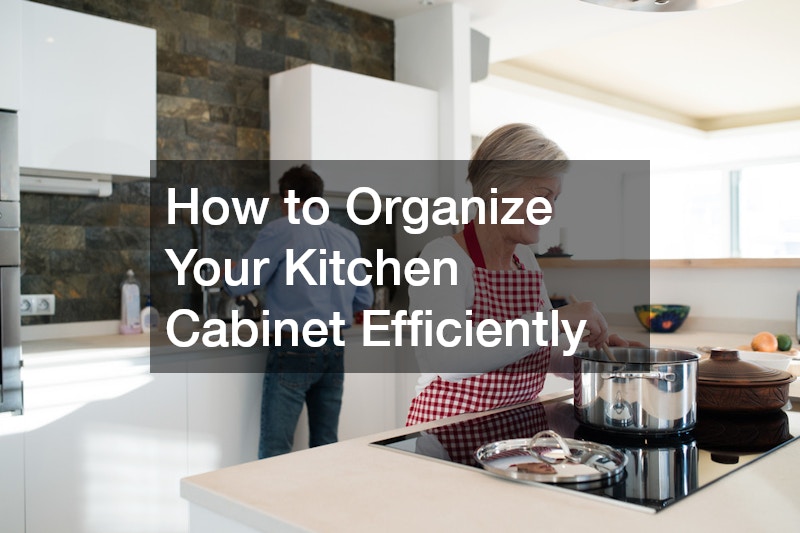
How to Organize Your Kitchen Cabinet Efficiently
An organized kitchen cabinet can transform your cooking experience by making it easier to find ingredients, utensils, and cookware. However, with limited space and a variety of items to store, keeping your cabinets neat and functional can be a challenge. By implementing practical strategies, you can maximize your cabinet space and create a kitchen that works for you.
Here’s a guide to organizing your kitchen cabinet efficiently.
Assess Your Current Cabinet Setup
Before you start reorganizing, take a close look at your current cabinet setup. Remove all items from your cabinets and sort them into categories, such as plates, bowls, spices, canned goods, and cooking tools. Discard expired food, donate items you no longer use, and set aside anything that doesn’t belong in the kitchen. This decluttering process is essential for creating a clean slate and ensuring you only keep what’s necessary. As you assess your cabinets, think about how you use your kitchen. Are there items you reach for daily that should be more accessible? Do certain cabinets feel overcrowded or underutilized? Understanding your habits and pain points will help you design an efficient organizational system tailored to your needs.
Group Similar Items Together
One of the most effective ways to organize your kitchen cabinet is by grouping similar items together. For instance, dedicate one cabinet shelf to plates and bowls, another to glassware, and a separate section for pantry staples. This system not only makes it easier to find what you need but also helps maintain order over time. Consider storing items by frequency of use. Place everyday essentials, such as coffee mugs and cereal bowls, on lower shelves within easy reach. Reserve higher shelves for seasonal or rarely used items, like holiday dishes or specialty appliances. Using this approach ensures that your cabinets remain functional and uncluttered.
Use Storage Solutions to Maximize Space
Kitchen cabinets often have unused vertical space that can be optimized with the right storage solutions. Add shelf risers to create additional levels for stacking plates or mugs. Use bins or baskets to group smaller items, like spice jars or snack packets, and prevent them from getting lost in the back of the cabinet. Lazy Susans are excellent for corner cabinets, allowing you to easily access items that would otherwise be hard to reach. Install pull-out drawers or organizers to make deep cabinets more user-friendly. Hooks and adhesive racks can also be attached to the inside of cabinet doors for storing small items like measuring spoons or pot lids.
Label Everything
Labeling your kitchen cabinet shelves and storage containers can save you time and frustration. Clear labels help everyone in your household know where things belong, making it easier to maintain organization. For pantry items, use clear containers with labels for ingredients like flour, sugar, or rice. This not only keeps food fresher but also eliminates the clutter of mismatched packaging. If you prefer a more discreet labeling method, consider using chalkboard paint or adhesive chalkboard labels that can be updated as needed. This way, you can adjust your system without creating a mess.
Prioritize Accessibility
Accessibility is key to an efficient kitchen cabinet setup. Arrange items so that the ones you use most frequently are easy to reach. For example, store pots and pans near the stove, utensils in a drawer near your prep area, and cleaning supplies under the sink. Keep heavier items on lower shelves to avoid accidents and reserve upper shelves for lighter objects. Rotating storage systems, such as tiered shelves or turntables, can also enhance accessibility by making it simple to grab what you need without moving other items. This is particularly useful for spices or canned goods.
Maintain a Regular Cleaning Schedule
An organized kitchen cabinet requires regular maintenance. Set aside time every few months to clean out your cabinets, wipe down shelves, and reorganize as needed. This routine ensures that your cabinets stay tidy and prevents clutter from accumulating again. Use this opportunity to check expiration dates on food items and inspect your cookware for damage. Reorganize based on any changes in your cooking habits or storage needs, and adjust your system to keep it functional and efficient.
Efficiently organizing your kitchen cabinet is a practical investment in your daily life. By decluttering, grouping similar items, using storage solutions, and maintaining a regular cleaning routine, you can create a functional and visually pleasing kitchen that simplifies your cooking experience. Whether you’re a seasoned chef or a casual cook, an organized cabinet is the key to a stress-free kitchen.
.

